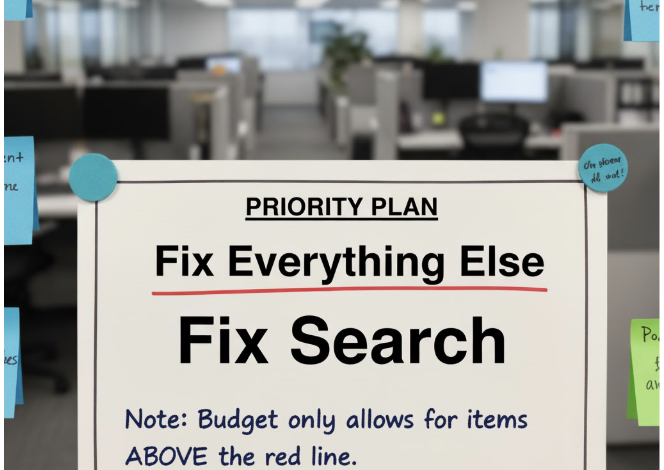
If you’re a digital workplace leader, intranet search has probably kept you up at night.
Everyone agrees it’s important—but fixing search rarely makes it above the budget redline. We nod in meetings and say, “We’ll fix search someday.” But for many organizations, “someday” never seems to come.
Back in 2016, I ran an intranet benchmark study through the Worldwide Intranet Challenge while leading digital communications at H&R Block. We wanted to understand how our employees felt about every part of their intranet experience compared to other organizations.
On paper, the results looked great—top-quartile scores across the board. “Finding information” even ranked #16 worldwide, just behind our strongest marks in overall experience and content quality.
But the real story came out in the open-ended comments.
The Voices Behind the Data
As we sifted through thousands of responses, one theme rose above all others:
“I can’t find what I’m looking for.”
It was the most common frustration—despite decent numeric scores. The disconnect was clear: our employees were struggling, and we needed to understand why.
We were using Elasticsearch, a reliable tool integrated with our platform. As someone who knew the content well, I rarely had trouble finding things myself. But that was exactly the problem: search should work for everyone, not just the people who built it.
Listening in the Moment: How We Collected Search Feedback
To capture insight right at the point of frustration, we launched a simple Search Feedback Form asking just three questions:
- What search terms did you use?
- What were you hoping to find?
- Which employee group are you part of?
This allowed us to recreate searches, investigate what went wrong, and tag each issue for analysis. Within weeks, the data told a powerful story.
Five Common Reasons Searches Fail
- The content doesn’t exist. Employees were looking for answers that had never been created.
- The content lives elsewhere. It was stored in external systems outside our search index.
- The terminology doesn’t match. Authors and employees were speaking different languages.
- The right result is overlooked. The answer was there—but users didn’t recognize it.
- The query isn’t effective. Employees used full questions instead of keywords, confusing legacy search engines.
Each pattern pointed toward a targeted solution—and a more structured way to fix search for good.
Turning Feedback into Action
Our process was simple but powerful:
- Recreate the failed search and categorize the issue.
- Thank the submitter and share what we found (or next steps).
- Track patterns to inform broader improvements.
Here’s what that looked like in practice.
- Filling the Gaps: When Content Was Missing
We routed feedback to subject matter experts to decide if new content was needed. Over time, we focused less on one-off requests and more on patterns—building what employees truly needed instead of chasing every rabbit hole.
- Bridging Silos: When Content Lived in Other Systems
A surprising amount of useful material was trapped elsewhere. Our fix was to create “wayfinding pages”—guides with links and context pointing to external repositories.
One major win: procedural content for frontline tax professionals accounted for 40% of failures. After migrating that content, related help desk calls dropped 19% year over year—a tangible business impact.
- Aligning Language: When Words Didn’t Match
Employees often searched for terms different from the ones used in official documentation. We:
- Enhanced keyword mappings behind the scenes.
- Shared feedback trends and verbatim comments with content owners.
- Hosted short workshops on plain-language writing.
These were small changes that paid off quickly.
- Boosting Visibility: When the Right Result Was Ignored
Sometimes the best match appeared—but users skipped past it. We refined the results page with clearer icons (pages, news, documents) and filters like “date modified.” These small cues built user confidence and engagement.
- Empowering Better Queries
Once structural issues were fixed, remaining problems came down to search habits. We published a short guide, “Intranet Search Tips,” teaching users how concise keywords beat full-sentence queries. A simple step, but it helped close the loop.
Results: From #16 to #4—and a Quieter Inbox
By the time we re-benchmarked in 2018, “search” had leapt to #4 globally, with improvements across every category.
But the real win was silence: complaints about search simply stopped. Employees were finding what they needed—and feeling supported in the process.
Looking Ahead: Search in the Age of AI
Now, with GPTs reshaping how we interact with information, it’s easy to assume traditional search tuning is obsolete.
But here’s the truth: AI amplifies the need for strong intranet search.
Why AI Makes Findability More Important Than Ever
- Garbage In, Garbage Out: AI is only as good as the content it draws from. Outdated or scattered data produces polished—but wrong—answers.
- Findability Fuels Intelligence: Even conversational interfaces depend on locating and ranking source material.
- Governance Is the New SEO: The focus shifts from keyword tweaks to defining trusted repositories and metadata.
- Transparency Builds Trust: Employees expect to see the sources behind AI-generated insights.
From Search Optimizers to AI Enablers
The skill set is evolving for digital workplace leaders. Instead of fine-tuning algorithms, digital workplace teams now:
- Curate and vet authoritative content sources.
- Ensure accuracy, freshness, and context.
- Train AI on organizational vocabulary.
- Audit outputs to uncover content or governance gaps.
As we look toward the future, I don’t believe AI will conjure perfect search from thin air. It will magnify how well your organization manages information. There’s never been a more important time to fix your search.




